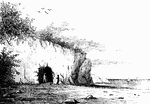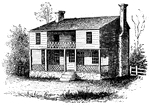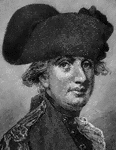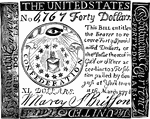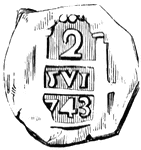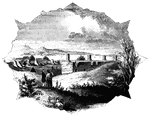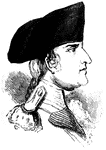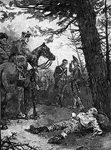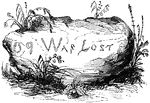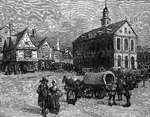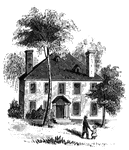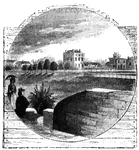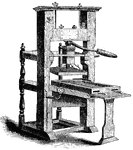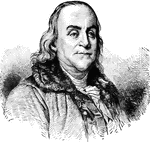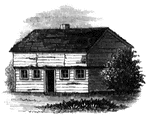!["View from the site of Fort Cornwallis. Fort Cornwallis occupied the ground in the rear of the Episcopal church, now a grave-yard. This view is from within the inclosure, looking northeast, and includes a portion of Schultz's bridge, the Savannah River, and Hamburg upon the opposite bank. In the foreground is seen portions of the church-yard wall, and upon the brink of the river below are [African Americans] employed in placing bales of cotton upon the wharves for transportation to the sea-coast. The wharves are two stories in height, one to be used at low water, the other when the river is 'up.' There were remains of the ditch and embankments of the fort within the grave-yard when I was there; and the trench leading to the water-gate, where the 'Pride-of-India tree is seen, was very visible."—Lossing, 1851](https://etc.usf.edu/clipart/14100/14143/ft-cornwalli_14143_mth.gif)
Fort Cornwallis
"View from the site of Fort Cornwallis. Fort Cornwallis occupied the ground in the rear of the Episcopal…
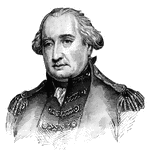
Lord Cornwallis
"Lord Cornwallis, key figure in the peace process between Britain and America."—E. Benjamin Andrews,…
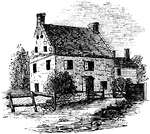
Cortelyou's House
"Cortelyou's House. This house, built of stone, with a brick gable from eaves to peak, is yet (1852)…
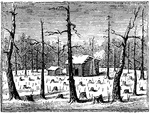
Cowpens
"Scene at the Cowpens. This name is derived from the cirumstance that, some years prior to the Revolution,…
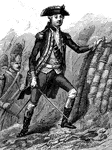
Admiral D'Estaing
A French general who led a fleet to aid the American patriots, but failed in a few attacks.
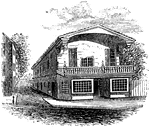
Lydia Darrah's House
The house of Lydia Darrah (1728-1789). Lydia was a midwife and Philadelphia's first female undertaker.…
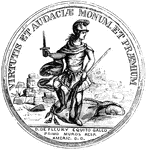
De Fleury Medal Front
"Medal awarded to Lieutenant-colonel De Fleury. This is a representation of the medal, the size of the…

Death of Terrapin, or the Embargo
A political cartoon criticizing the Embargo placed upon the American colonies by the British. The cartoon…

Garden House in Which Jefferson Celebrated the Passage of the Declaration
The garden house in which Jefferson and others celebrated the passage of the Declaration of Independence.

Table and Chair Used at the Signing of the Declaration of Independence
The table and chair used at the signing of the Declaration of Independence.

DePeyster Raises a White Flag
Arent DePeyster, a British military officer of the American Revolution, surrenders at the Battle of…

Dining-Hall
"The dining-hall, or room with seven doors. In the December number of the New York Mirror for 1834,…
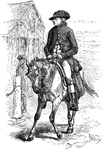
Ebenezer Dorr
"While Paul Revere is riding out through Medford, Ebenezer Door, mounted on an old plod-jogging horse,…
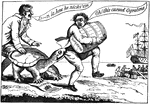
Embargo
A political cartoon criticizing the Embargo placed upon the American colonies by the British.
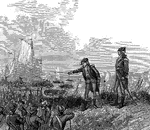
General Glover Superintending the Embarkation
"The regiment was commanded by Colonel Glover, and General Washington selected him as the fittest person…

Ethan Allen Tomb
Tomb of Ethan Allen as seen in 1851. Shortly thereafter, this original plaque disappeared. In 1858,…
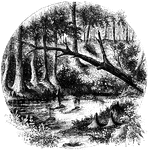
Eutaw Spring
"Eutaw Spring, where there was a conflict during the American Revolution."—Lossing, 1851

Mrs. Falls'
"Mrs. Falls'. This house, now (1850) owned by Mr. Samuel Moore, is a frame building, and stands on the…
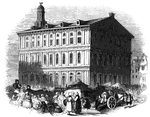
Faneuil Hall
"Faneuil Hall has been denominated 'the cradle of American liberty,' having been the popular gathering-place…
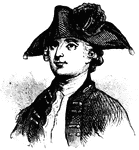
Edmund Fanning
(1739-1818) Lieutenant-governor of Nova Scotia and of St. John's Island. Born in the colony of New York,…

first interview
Site of the first interview between Gates and Burgoyne. This view is taken from the turnpike, looking…
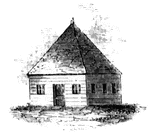
First Meeting House
First meeting hall. This picture of the first house for Christian worship erected in Connecticut is…
Fitch's Point
Fitch's Point, the landing-place of the British. This view is from the west side of Gregory's Point,…
Flag Staff
"Flag-staff, Fort Washington. This flag-staff, indicating the center of the fort, is a prominent object…

Floating Battery
"American Floating Battery. I am indebted to the kindness of Peter Force, Esq., of Washington city (editor…
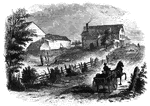
Fort Anne
Site of Fort Anne. This view is from the bridge which crosses Wood Creek, looking south. The distant…

Fort at Chambly
Fort at Chambly, this is a view of the south and west sides of the fort, looking toward the river. It…

Fort Chambly
Fort Chambly at the foot of the Chambly rapids on the Richelieu River in Quebec, Canada, was built by…
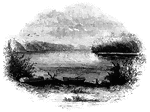
Fort Miller
Fort Miller fording-place. This was the crossing-place for the armies; and there are still to be seen…
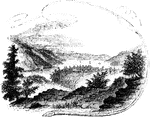
Fort Montgomery
"View near Fort Montgomery. This view is from an eminence near the mountain road, about three quarters…
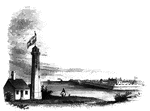
Fort Niagra
Distant view of Fort Niagra. This view is from the west side of the Niagra River, near the light-house.…

Fort Oswego
View of Oswego and the Fort in 1798. This view is from the west side of the river, near the site of…
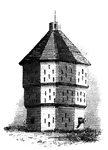
Fort Plain
Fort Plain block-house. There is considerable confusion in the accounts concerning Fort Plain, for which…

Benjamin Franklin
"Benjamin Franklin managed men, the whilom printer, king's postmaster-general for America, discoverer,…

Fraser Burial
Fraser's burial-place. The hill on which the 'great redoubt' was erected, and where General Fraser was…
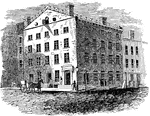
Fraunces Tavern
In August of 1775, Americans took possession of cannons from the Battery at the tip of Manhattan and…

Frederica
"Ruins of Oglethorpe's Barracks at Frederica. This is from a sketch made by W. W. Hazzard, Esq., in…
!["View of the remains of the French Works. These remains are in the southeastern suburbs of the city, about half way between the [African American] Cemetary and the residence of Major William Bowen, seen toward the right of the picture. The banks have an average height, from the bottom of the ditch, of about five feet, and are dotted with pines and chincapins or dwarf chestnuts, the former draped with moss. The ground is an open common, and although it was mid-winter when I was there, it was covered with green grass, bespangled with myriads of little flowers of stellar form. This view is from the direction of the town looking southeast."—Lossing, 1851](https://etc.usf.edu/clipart/14100/14147/french-works_14147_mth.gif)
French Works
"View of the remains of the French Works. These remains are in the southeastern suburbs of the city,…

